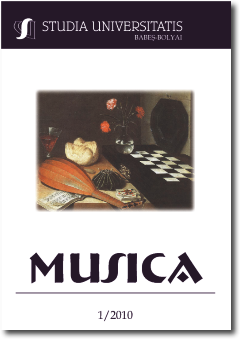THE OSMOSIS OF THE DIVERSITY IN MAURICE RAVEL’S WORK
Keywords:
psycho aesthetic principles, cultural background, dialog with contemporary artistic trends, duplication, impressionism, musical language, harmony, tone-colourAbstract
Our study investigates the unity-diversity dichotomy of Maurice Ravel’s oeuvre based on the following factors: psycho‑aesthetic principles, cultural background and the dialog with contemporary artistic trends. As a whole, his work shows some permanent aesthetic and stylistic reference points experimented and used since his impressionist period, mostly in piano and orchestral pieces. Similarly to Debussy, Ravel widely employs the duplication technique, as a basic style element of musical impressionism. Due to the duplication, which affects both the linear and horizontal parameters of the construction, his work absorbs in a coherent language, a large number of style elements and composition solutions from the French, Spanish, Russian and extra‑European cultures. This creative feature corresponds to his neutral aesthetic position, as a source of the artistic dialog between the past and the present, the rational and the inspirational, the local and the foreign art. Our analysis, mainly focused on his impressionist piano works, proposes to identify different coherency levels of Ravel’s musical language, as a source of many hermeneutic reflections.
References
*** The Cambridge Companion of Ravel (ed. by Deborah Mawer), Cambridge University Press, Cambridge, 2000
Angi, István, Lectures on Musical Aesthetics, vol. II, University of Oradea Press, 2004
Boulez, Pierre, Penser la musique aujourd'hui, Éd. Gouthier, 1964
Gadamer, Hans-Georg, Truth and Method, Sheed and Ward, London, 1975
Orenstein, Arbie, Ravel. Man and musician, Columbia University Press, New York and London, 1975
Ruwet, Nicolas, Langage, musique, poésie, Seuil, Paris, 1972
Ţăranu, Cornel, Elements of musical stylistics, “Gh. Dima” Conservatory, Cluj-Napoca, 1981
Viñes, Ricardo, Des Souvenirs d’enfance et d’adolescence, La Revue Musicale Dec., 1938
Downloads
Published
How to Cite
Issue
Section
License
Copyright (c) 2010 Studia Universitatis Babeș-Bolyai Musica

This work is licensed under a Creative Commons Attribution-NonCommercial-NoDerivatives 4.0 International License.



